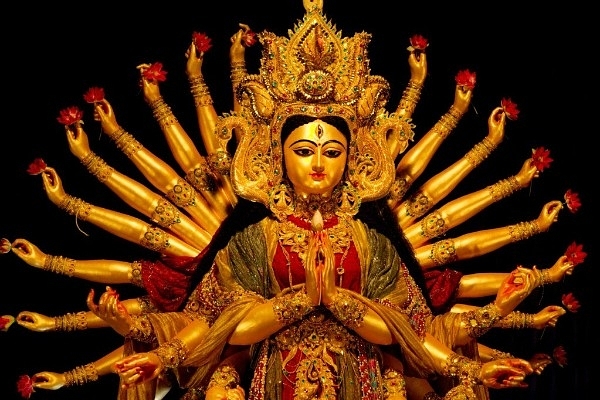Blogs
Navaratri Reflection On 2,000-Year-Old Tamil Verses In Praise Of Durga
- If you wish to know how Tamil culture richly contributed to Devi worship, then a study and appreciation of the iconic Silappathikaram is a great beginning.

Durga.
If you are looking for Tamil verses in praise of ‘Devi’ this Navaratri, be sure to reach out for the Silappathikaram, written about 2,000 years ago in the Tamil Chera kingdom, by a prince-turned-monk ‘Illango Adigal’.
The Silappathikaram is regarded as one of the five great Kavyas in classical Tamil, the other four being Manimekalai, Jeevaka Chintamani, Valayapati and Kundalakesi.
It is dated to the period 150 BCE to 150 CE and is a spectacular work describing the culture of the Tamil-speaking region as it unravels a plot centered around the merchant noble Kovalan, his dear wife Kannagi and his consort Madhavi, a courtesan endowed with superlative beauty, knowledge and talent.
Dramatic events unfold in this story as Illango Adigal weaves in extraordinary descriptions of Tamil music theory and classical dance (kootthu) even as he describes Madhavi’s prowess.
The story takes readers through the Chola kingdom with ample descriptions of Kavirippoompattinam and references to places such as Tiruvenkatam (Tirupati), Tiruvarangam (Srirangam) et cetera, through the Pandya kingdom with its capital in the city of Madurai and through the Chera kingdom on the west coast of India.
In this vast work, are three noteworthy musical segments — Aaichiyar kuravai (the dance of the cowherd women (gopis) ), Vettuva vari — the song/dance of the hunter-folk and the Kurinjippattu; while the Kuravai is in praise largely of Krishna (and the various avatars of Vishnu such as Rama, the slayer of Ravana), the Kurinjippattu is in praise of Murugan, the Vettuva vari is in praise of Kottravai or Durga (in addition of course to the kAnal vari and the ArangEtra kAthai).
This set of verses from Vettuva vari described below is probably one of the oldest and finest poetry in praise of Durga (Mahishasura mardini).
Kovalan, Kannagi and the Saint Kavunti witness the ritual dance of the tribes-folk, led by ‘sAlini’ — the lady endowed with the rights to carry out this dance while being possessed by the force of the Goddess, while the other members offer their obeisance to the (energy of the) Goddess in her.
The song’s words ring loud and clear.
Now, the Durga Saptashati, which is part of the Markandeya Purana, is a text which is central to the worship of Durga during Navaratri in several parts of the country.
Also popularly recited is the Mahishasuramardini Stotram attributed to Adi Sankara, generally dated to around the 8th century CE. The Durga Saptashati (Devi Mahatmiya/Chandi Path) are generally dated anywhere between 250 and 450 CE.
The Lalita Sahasranamam with a 1,000 names of Devi is a revered work that dates back to the 4th century CE and is popular throughout India; (please note, however, that historian Ramachandra Dikshitar assigns an earlier date of 400 BCE to the Brahmanda Purana that showcases the Sahasranama).
It is clear that the Tamil verses of Illango Adigal, in praise of the Goddess, pre-date the popular liturgical sources above and are clearly illustrative of a robust tradition of Devi worship in Tamil Nadu well before the origin of the Devi Mahatmiya, honouring her destruction of the demon Mahishasura — who is again consistently depicted in the form of a wild buffalo.
The verses further describe Kotravai unambiguously as the consort of Shiva and also as endowed with attributes of Maha Vishnu such as the shankha and the chakra.
The verses and their rhythm are easily read in a 12/8 (trisra) framework in the context of a folk melody and could well have been written in the 20th century.
Here is a choral performance of these verses set to tune and orchestrated in the Tamil folk idiom by the author of this article; this music was presented earlier at the World Tamil Conference in Chicago in July 2019.
The contemporary feel of the lyrics and the tune is not lost upon the listener. Words such as Aanai, puli, erumai — refer to the animals elephant, tiger and buffalo.
The word ‘Mayidan’ refers to ‘Mahisha’ and the word ‘maRai’ refers to the Vedas.
Illango Adigal’s praise of Durga does not stop here. The maRavas of the region revere Devi’s dance celebrating her victory over the Asuras.
They celebrate the cheerful chants of the Devas; they call out to her as ‘Shankari’, ‘Antari’ and ‘Neeli’ and describe her as the one endowed with the third eye and the Crescent Moon (similar to the epithets described in liturgical works).
The entire chapter ‘Vettuva vari’ is a detailed description of the worship of ‘Kotravai’ or ‘Durga’ in the Pandya-Kingdom, where sacrificial offerings are made to the young lass, bearing the energy of and representing the Goddess.
The connection between Kotravai, folk music and dance traditions in the Tamil world is an ancient, yet timeless one as these verses illustrate.
One of the wishes on the author’s bucket list is to re-record this song with a spirited voice similar to that of LR Easwari, and enable this timeless Tamil song in praise of the ‘Mother’ to be heard all over Tamil Nadu during the festival month of Aadi — and during Navaratri.
Below are the lyrics in Tamil:
Introducing ElectionsHQ + 50 Ground Reports Project
The 2024 elections might seem easy to guess, but there are some important questions that shouldn't be missed.
Do freebies still sway voters? Do people prioritise infrastructure when voting? How will Punjab vote?
The answers to these questions provide great insights into where we, as a country, are headed in the years to come.
Swarajya is starting a project with an aim to do 50 solid ground stories and a smart commentary service on WhatsApp, a one-of-a-kind. We'd love your support during this election season.
Click below to contribute.
Latest